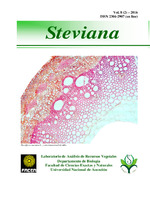Morfo-anatomía foliar y caulinar de Passiflora caerulea L. (Passifloraceae)

Date
2016-12-01Author
Pereira Suhsner, Claudia Diana
Ferrucci, María Silvia
Honfi, Ana Isabel
Metadata
Show full item recordAbstract
Se estudió la morfo-anatomía foliar y caulinar de P. caerulea con el objeto de identificar caracteres que permitan reconocer a la especie. El material vegetal fue colectado en el Distrito Félix Pérez Cardozo, Dpto. Guairá. Se realizaron observaciones directas y al microscopio estereoscópico de las partes vegetativas y reproductivas para la caracterización botánica. Los cortes transversales foliares y caulinares se realizaron con micrótomo rotatorio manual y se aplicó tinción directa con safranina (1%), posteriormente se montaron en Bálsamo de Canadá. P. caeruleaes una liana con tallo pentangular, zarcillos con torsiones descomprimidas, hojas simples, alternas, tri-a pentalobada; pecíolo con glándulas estipitadas, flores solitarias y axilares. Los caracteres anatómicos que la distinguen están dados por las células epidérmicas de ambas superficies con paredes celulares onduladas, estomas y aparatos estomáticos anomocíticos y parasíticos restringidos a la superficie abaxial, mesófilo dorsiventral, las drusas se localizan en el parénquima de la vena media y en la vaina de los hacecillos vasculares, medula hueca, entre otros. Los detalles anatómicos permiten distinguir a P. caerulea. We studied the leaf and stem morphoanatomy of P. caeruleaorderto identify species specific characters. The plant material was collected in the Felix Perez Cardozo District, DepartmentofGuairá, Paraguay. Direct and stereoscopic microscope observations of the vegetative and reproductive parts were carried out for the botanical characterization. The leaf and stem cross sections were performed with a manual rotary microtome and direct staining with safranin (1%), was applied. P. caeruleais a liana with pentangular stem, tendrils with decompressed twisting; simple leaves, alternate, tri-to penta lobed; petiole with stipitate glands; solitary and axillary flowers. The anatomical characteristics found were: adaxial and abaxial epidermis with wavy edge, anomocytic and parasitic stomata type in the abaxial face; bifacial mesophyll with dorsiventral symmetry; drusen located at the middle vein parenchyma and at the sheath of vascular hooks; hollow medulla, and others. Anatomical details allow ti distinguish P. caerulea.
Collections
The following license files are associated with this item:



